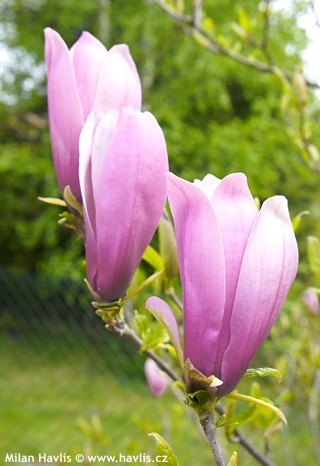Magnolia 'GEORGE HENRY KERN'

Magnolia 'GEORGE HENRY KERN'
magnolia
magnolia
| SIZE/TYPE | medium-sized shrub |
|---|---|
| USUAL HEIGHT | 2-3m |
| USUAL WIDTH | 1-1.5m |
| LEAVES | deciduous broadleaf |
| COLOUR OF LEAVES |
 green green |
| FLOWERS | showy |
| COLOUR OF FLOWERS |
 pink pink
|
| BLOOMING TIME | April - April |
| LOCATION | full to partial sun |
| SOIL TYPE | acidic (peaty) |
| SOIL MOISTURE REQUIREMENTS | evenly moist (dislikes drought) |
| USDA zone (lowest) | 5 (down to -29°C) |
| WINTER PROTECTION | |
| FOR ZONE 5+6 |

|
| FOR ZONE 7 |

|
| BELONGS TO CATEGORIES |
Deciduous broadleaf Magnolias |
George Henry Kern magnolia is a breeding success from the USA. It is a cross between magnolia stellata and magnolia liliiflora "NIGRA". The result is a magnolia with soft pink, 8-petalled, fragrant flowers in late April. It may repeat flowering with a few flowers in July but they do not open entirely since they do not like summer heat. The deciduous leaves are fresh green, narrowly to widely elliptic and densely cover the whole plant when in leaf. It grows slowly into a compact, widely pyramidal, extremely floriferous shrub, reaching maturity in about 20 years.
This magnolia was developed by my Carl Edward Kern Sr. originally from Horn, Switzerland. He named his new discovery after his son, George Henry Kern, a U.S. Navy Office, who was killed in a terrible train wreck when returning to duty during World War II. This piece of interesting information behind the name origin was supplied by his son David E. Kern who accidentally found our website and wanted to share it with us. He also expressed his joy that his grandfather’s magnolia is still recognized in Europe and that his grandfather would surely be pleased, too. So are we and to be honest the plant is not only recognized but also popular for its later flowering, good hardiness, and compact habit.
Magnolias are not supposed to be pruned. You can prune old shrubs if ill, or trim them to shape or to reduce size, or make an elementary cut to young plants of unsightly or unhealthy appearance. Do this as soon as possible after flowering to secure setting of flower buds for the following year. Be aware that each magnolia can respond differently to pruning.
Deciduous magnolias are quite easy plants. All they need is light, well-drained, acidic soil with equal moisture throughout the year. Once established they can do with occasional drought but will not look as nice as the ones with regular watering. Just pay attention to how to plant your magnolia. First, find it a spot where it will live forever and ever. It does not like transplanting. And as it makes shallow roots reaching well over its spread stay away from disturbing the roots by digging or messing about around it. Just cover the soil with bark mulch and do not plant anything else near it after say the second year after planting onwards. You could damage the very important top roots that absorb maximum moisture and nutrients from the soil. Also avoid planting magnolia too deep. It is hardy to about -29°C (USDA zone 5).
Last update 23-01-2013; 04-02-2015
SIZES and PRICES
CURRENTLY SOLD OUT
GLOSSARY
|









